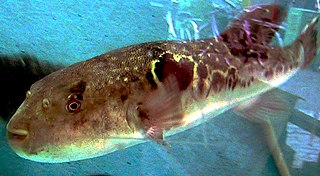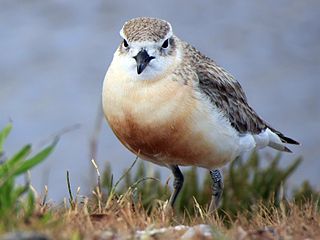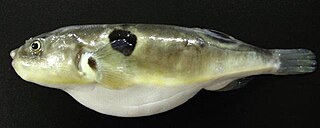
Herring are various species of forage fish, mostly belonging to the family Clupeidae.

The skimmers, forming the genus Rynchops, are tern-like birds in the family Laridae. The genus comprises three species found in South Asia, Africa, and the Americas. They were formerly known as the scissorbills.

The dusky dolphin is a dolphin found in coastal waters in the Southern Hemisphere. Its specific epithet is Latin for "dark" or "dim". It is very closely genetically related to the Pacific white-sided dolphin, but current scientific consensus holds they are distinct species. The dolphin's range is patchy, with major populations around South America, southwestern Africa, New Zealand, and various oceanic islands, with some sightings around southern Australia and Tasmania. The dusky dolphin prefers cool currents and inshore waters, but can also be found offshore. It feeds on a variety of fish and squid species and has flexible hunting tactics. The dusky dolphin is known for its remarkable acrobatics, having a number of aerial behaviours. The status of the dolphin is unknown, but it has been commonly caught in gill nets.

Takifugu, also known by the Japanese name fugu, is a genus of pufferfish with 25 species, most of which are native to salt and brackish waters of the northwest Pacific, but a few species are found in freshwater in Asia or more widely in the Indo-Pacific region. Their diet consists mostly of algae, molluscs, invertebrates and sometimes crustaceans.

The New Zealand dotterel is a species of shorebird found only in certain areas of New Zealand. It is also called the New Zealand plover or red-breasted plover, and its Māori names include tūturiwhatu, pukunui, and kūkuruatu.

The dusky shark is a species of requiem shark, in the family Carcharhinidae, occurring in tropical and warm-temperate continental seas worldwide. A generalist apex predator, the dusky shark can be found from the coast to the outer continental shelf and adjacent pelagic waters, and has been recorded from a depth of 400 m (1,300 ft). Populations migrate seasonally towards the poles in the summer and towards the equator in the winter, traveling hundreds to thousands of kilometers. One of the largest members of its genus, the dusky shark reaches more than 4 m (13 ft) in length and 350 kg (770 lb) in weight. It has a slender, streamlined body and can be identified by its short round snout, long sickle-shaped pectoral fins, ridge between the first and second dorsal fins, and faintly marked fins.

Handfish are marine ray-finned fishes belonging to the family Brachionichthyidae, a group which comprises five genera and 14 extant species and which is classified within the suborder Antennarioidei in the order Lophiiformes, the anglerfishes. These benthic marine fish are unusual in the way they propel themselves by walking on the sea floor rather than swimming.

Bagrichthys is a genus of bagrid catfishes.

The Appalachian cottontail is a species of cottontail rabbit in the family Leporidae. It is a rare species found in the upland areas of the eastern United States.

The stone moroko, also known as the topmouth gudgeon, is a fish belonging to the Cyprinidae family, native to Asia, but introduced and now considered an invasive species in Europe and North America. The fish's size is rarely above 8 cm and usually 2 to 7.5 cm long.
Semilabeo notabilis is a species of freshwater ray-finned fish belonging to the family Cyprinidae, the family which includes the carps, barbs. minnows and related fishes. This fish is found in the Jingshajiang sub-basin of the Yangtze and in the basins of the Pearl River and the Red River in southern China and northern Viet Nam.

Crossocheilus, also known as the fringe barbs, flying foxes, or "algae eaters", is a genus of fish in the family Cyprinidae. It is distributed in China, India, Indonesia, Malaysia and Thailand in Asia. These fish occur in several types of habitat, often fast-flowing rivers with rocky bottoms.
Semilabeo is a genus of freshwater ray-finned fish belonging to the family Cyprinidae, the family which includes the carps, barbs. minnows and related fishes. The fishes in this genus are found in southern China and Viet Nam.
Enneapterygius obscurus is a species of triplefin blenny in the genus Enneapterygius. It was described by Eugenie Clark in 1980. It is found in the Red Sea but the finding of a specimen at Malindi in Kenya suggests it may have a wider distribution.
The longfin gurnard, the long-finned gurnard or shining gurnard, is a species of ray-finned fish belonging to the family Triglidae, the gurnards and sea robins. This fish is found in the eastern Atlantic Ocean, including the Mediterranean Sea and the Black Sea. This species is of commercial importance as a food fish.
Crossocheilus obscurus is a species cyprinid fish. It occurs on Sumatra (Indonesia) and in Peninsular Malaysia. It lives in fast flowing steams with rocky substrate.
Pseudogyrinocheilus is a monospecific genus of freshwater ray-finned fish belonging to the family Cyprinidae, the family which also includes the carps, barbs, minnows and related fishes. The ony species in the genus is Pseudogyrinocheilus prochilus which is found in the Yangtze River and its tributaries in China.

The northern New Zealand dotterel or northern red-breasted plover is a shorebird which breeds exclusively on beaches in New Zealand's North Island.

Takifugu obscurus or the obscure pufferfish is a species of euryhaline, anadromous pufferfish first described by T. Abe in 1949. It has been categorized by the IUCN as a least-concern species globally since 2014; in South Korea, it is however classified as an endangered species due to overfishing of its endemic populations. The Catalogue of Life lists no subspecies of Takifugu obscurus. The species prefers deeper, clearer areas of brackish and fresh water, and is found in estuaries, as well as rivers and tributaries thereof such as the South Korean rivers Geum, Han, and Imjin, or the Tamsui River. The species is endemic to North and South Korea, the Sea of Japan, and the East and South China Seas. Uses of Takifugu obscurus include human consumption, use in animal testing, and owning specimens as pets. As with most species of pufferfish, several organs of Takifugu obscurus contain tetrodotoxin, making it potentially poisonous if not prepared safely by trained persons.













